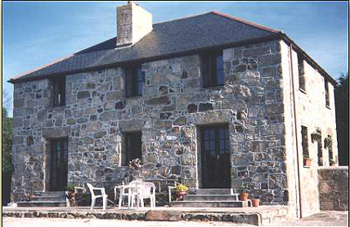March 5, 2007
Siding: When a Cover-Up Can Be a Good Thing

By Michael D. Shaw
Popular architecture writer Jackie Craven says that nothing impacts the appearance of your home more dramatically than the siding, and few would dispute this. Even beautiful landscaping won’t do much if it surrounds a shabby residential exterior.
Perhaps that is why siding is one of the most hotly disputed areas of home improvement, and probably one of the most scam-prone, as well. You might recall that the movie Tin Men (1987) was devoted to the misadventures of two aluminum siding salesmen.
The whole matter of siding impacts the environment in many ways: Extravagant claims are often proffered for energy savings; certain of the materials may be hazardous during application, manufacturing, or in a fire; differences in required maintenance affect the use of paintings and coatings that can have environmental consequences; and, of course, the siding literally impacts the very elements of the outdoor environment, including the weather and insects!
As to the energy claims, proponents of siding materials can tout all sorts of statistics, and some of these might actually include scientific tests, but even the best of the R-values claimed will pale in comparison to typical residential insulation materials. [R-value measures thermal resistance—the higher the better.]
So, choosing a siding material should be based on your budget, the amount of maintenance you are willing to tolerate, appearance, and durability—not energy savings.
The most popular siding materials include:
- Aluminum and vinyl
- Brick and stone
- Cedar shingles and wood clapboard
- Engineered wood
- Fiber cement
- Seamless steel
- Stucco
While vinyl siding has pretty much taken over this segment of the market, some builders offer aluminum as a more fireproof alternative. Aluminum can dent, but vinyl can crack. The color of most vinyl siding penetrates all the material, unlike aluminum. Both offer good insect resistance, and they do not have to be painted. When burned, vinyl can give off toxic by-products, but there is also much overblown hysteria regarding the dangers of this material.
If you want something that can last for thousands of years, and keeps looking great with virtually no maintenance, consider stone. (Granite, limestone, and slate are often utilized.) But, be prepared to pay dearly for the privilege. Precast stone veneers capture the look and many of the desirable properties of stone at a much lower price tag.
While brick can’t boast a lifetime in the thousands of years, how about only hundreds? Fireproof and nearly indestructible, brick has been a favorite for generations, although it is costly. That’s why brick veneers are available that, again, mimic many of the desirable properties for less money.
Cedar shingles and wood clapboard have a good look, but can require considerable maintenance, and can be susceptible to insect damage. Fire resistance is not a strong suit.
Engineered wood improves on many of the qualities of real wood, and does present a more natural appearance than vinyl or aluminum siding. Still, maintenance requirements are an issue.
Fiber cement siding can have the appearance of wood, stucco, or masonry, although the wood-like finishes are most often chosen. Less expensive than wood, and needing far less maintenance, fiber cement offers excellent fire and insect resistance, and often comes with decades long warranties.
Vendors of seamless steel siding remind us that other siding materials are supplied in 12-foot lengths, and thus produce an average of 130 splices per home installation. Splices are a weak link, and can be an entry point for damaging moisture. Steel, of course, is extremely strong, and the material is usually finished to offer a wood-like appearance. One popular option has the material outfitted to simulate a log exterior. Little maintenance in required.
Stucco is a cement-based material that has been around since the Renaissance, and can be quite impervious. Sundry coatings can be applied to stucco, with differing maintenance demands. A number of synthetic stucco materials have been used for the past 50 years, with varying degrees of success.
Finally, regardless of the siding material you choose, be sure to thoroughly investigate your contractor, and determine how deep the warranty support really is. As in all things, you usually get what you pay for, and there are not only inferior versions of nearly all siding materials out there, there are unfortunately many unscrupulous operators who will grab a free ride on the backs of quality products with similar-sounding names.
A little extra time spent in due diligence will assure you the best siding job possible.

